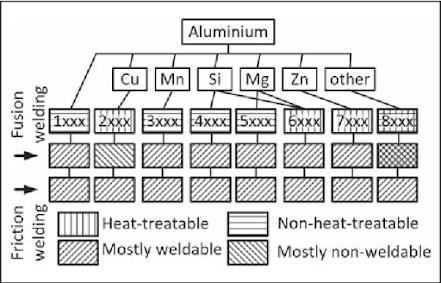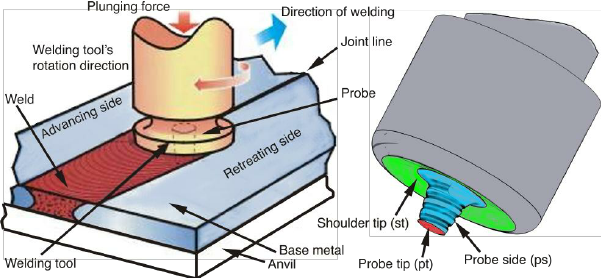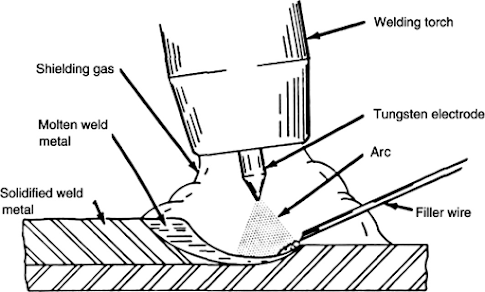WELDABILITY
OF Al AND IT’S ALLOYS
Aim
To investigate the weldability of Aluminum and its
Alloys.
Objectives
1 To know the weldability of Aluminum
2 To know the weldability of Some of
the Alloys of Aluminum
Abstract
A material’s weldability, also known as joinability,
relates to its ability to be welded. Welding may be done on a variety of metals
and thermoplastics, but some are easier to work with than others. The
weldability of a material is used to determine the welding procedure and to
compare the quality of the finished weld to that of other materials. Specific commercial alloys are
designated by a four-digit designation based on international requirements for
wrought alloys or the ISO alpha-numeric system. Non-heat-treatable alloys and
heat-treatable alloys can be further classed based on how the alloying elements
develop mechanical properties.
Keywords – Aluminum alloys, aluminum oxide, shielding gases,
anodizing, aluminum welding process selection.
Introduction
Due
to favorable qualities like as light weight, ease of machining, and corrosion
resistance, aluminum and its alloys have become more important in structural
engineering. This article discusses the surface-related issues that aluminium
welding faces, notably weld process and joint restrictions. The methodological
approach consists of a thorough assessment of published literature and results
based on eight industrial aluminium welding procedures and six joint types. It
is demonstrated that issues such as heat input control, hot cracking, porosity,
and weldable thickness vary depending on the technique utilized, and that there
is no one-size-fits-all weld process for all aluminium alloys and thicknesses.
A table is provided to aid in the selection of the best process for a certain
application. This study demonstrates the importance of understanding weld constraints
when choosing appropriate welding procedures.
Material Type
Because
pure aluminum is rather soft, alloying elements are added in small amounts to
give a variety of mechanical qualities. Specific commercial alloys are
designated by a four-digit designation based on international requirements for
wrought alloys or the ISO alpha-numeric system. Non-heat-treatable alloys and
heat-treatable alloys can be further classed based on how the alloying elements
develop mechanical properties.
Process factors
While
weldability can be defined broadly for a variety of materials, some welding
methods are better suited to particular materials than others. The quality of a
weld can vary substantially even within a single operation, depending on
variables such as electrode material, shielding gases, welding speed, and
cooling rate.
Non-heat-treatable alloys
Work
hardening and solid solution hardening of alloy elements such as magnesium and
manganese determine material strength; alloying elements are mostly found in
the 1xxx, 3xxx, and 5xxx series of alloys. These alloys may lose their work
hardening properties when welded, resulting in softening of the HAZ next to the
weld.
Heat-treatable alloys
The hardness
and strength of a material are determined by its alloy composition and heat
treatment (solution heat treatment and quenching followed by either natural or artificial
ageing produces a fine dispersion of the alloying constituents). The 2xxx,
6xxx, and 7xxx series specify the main alloying components. The hardening
components in the HAZ are redistributed during fusion welding, reducing
material strength locally.
Processes
TIG, MIG,
and oxyfuel procedures can be used to fusion weld most wrought grades in the
1xxx, 3xxx, 5xxx, 6xxx, and medium strength 7xxx (e.g. 7020) series.
Weldability is particularly good in the 5xxx family alloys. Because of the risk
of liquation and solidification cracking, high strength alloys (e.g. 7010 and
7050) and most of the 2xxx series are not suggested for fusion welding.
Friction Stir Welding is a process that works well with
aluminum alloys. It can produce sound welds in a wide range of alloys,
including heat treatable metals that are prone to hot cracking during fusion
welding.
Friction Stir Welding of Aluminum
Aluminum Arc Welding
Filler Alloys
The composition of the filler metal is governed by:
1: The parent metal’s weldability
2: The weld metal’s minimal mechanical characteristics
3: Resilience to corrosion
4: Criteria for anodic coating
Non-heat-treatable alloys are frequently filled with
nominally corresponding filler metals. Non-matching fillers are used to prevent
solidification cracking in alloy-lean materials and heat-treatable alloys.
For TIG and MIG welding, BS EN 1011 Pt 4:2000 specifies the
filler metal composition for the various weldable alloys; recommended filler
metal compositions for the more widely used metals are given in the Table.
References
1 https://en.wikipedia.org/wiki/Weldability#Aluminium
3 https://en.wikipedia.org/wiki/Weldability#Aluminium
4https://www.tandfonline.com/doi/abs/10.1080/09507110109549361?journalCode=twld20
7https://link.springer.com/article/10.1007/s13632-020-00675-w





